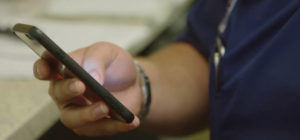Clinicians are burning out on a massive and unsustainable scale. According to one survey, 1 in 3 physicians had signs of clinician burnout —which raises the risk that they will emotionally check out while on the job. When admin tasks take time away from patient interactions, it makes things worse: Some evidence suggests that just 13 percent of a physician’s day is spent with patients.
Technology is as much the problem as it is the answer. Scrappy or cumbersome solutions can lead to an abundance of bottlenecks, distractions and alarm fatigue that have a devastating effect on patient outcomes, workflows and a clinician’s mental fortitude.
This past March, Kaiser Health News and Fortune gave the phenomenon a name: “Death by 1,000 Clicks,” referring to the digital overload of technologies that take time and mental capacity away from tapped-out clinicians.
But when launched and maintained in a strategic way, a clinical communication and collaboration (CC&C) tool can solve those very issues because it acts as a clinical enabler, rather than a clinical disabler. The question is, what makes a tool good or bad for clinician burnout?
Of course, it varies from hospital to hospital. But as a general rule, solutions that account for these needs can help free up clinicians to spend their time where it ought to be: with patients.
1. Single-Source Alerts
Daily alerts are an important part of the job, but they shouldn’t be so pervasive that clinicians get desensitized and tune them out. Opt for solutions featuring inbound alerting that consolidates pings from multiple sources into a single-app channel, like with MH-CURE.
When a lab or imaging result is ready, for example, clinicians can notify relevant care team members, and only them, directly on the MH-CURE app. There’s no fumbling with multiple phones, pagers or laptops—which minimizes the number of beeps, buzzes and rings a physician hears each day.
It’s about to get even better. Currently, Mobile Heartbeat engineers are working on a pair of updates to MH-CURE’s alert system that will:
- Feature customizable alert sounds by type, like making emergency alerts sound different than lab results.
- Enable clinicians to respond to an alert directly from the alert notification.
Expect those exciting new features in the next MH-CURE release.
2. Customizable Broadcasts
Of course, there will always be occasions for mass messages, but they don’t necessarily have to go to everyone. To optimize them, look for solutions that can customize broad messages to selected groups. For example, a message intended for charge nurses or residents should only be sent to those individuals.
MH-CURE’s Broadcast feature allows admins to configure multiple broadcast recipient groups throughout the facility. Make those groups as large or small as you want—from a patient’s specific care team to everyone on the floor, unit or even the whole hospital. That way, clinicians can step out of conversations they don’t need to see while staying in the loop of the ones they do.
3. Real-Time Enterprise Directory
Clinicians need always-on access to a hospital-wide directory; when they need to reach out for a consultation or get in touch with other care team members, it should be a searchable tap away. But too often, it’s not—and finding the right person becomes a manhunt that takes time away from more important things. Even more than that, it increases the risk of bad assumptions that lead to mix-ups and medical errors.
That’s why an enterprise directory is table stakes—all CC&C platforms should have one. But making that directory searchable, adaptable and customizable in real-time, as with MH-CURE, takes the utility up a notch.
Versioning, of course, is a big part of that. Some directories may require time-lagged updates to keep the lists clean after turnover and transition. With MH-CURE’s Active Directory Synchronization, however, changes are reflected in the live app as soon as the admin makes them. From the clinician’s perspective, it’s like having a real-time Rolodex in their back pocket: they can just tap, type and go.
4. Designated Roles
Having transparency in a patient’s care team is paramount. At any given moment, a clinician should know—in no uncertain terms—exactly which nurses, doctors and specialists are assigned to each patient. They don’t have time to check whiteboards or ask around, so CC&C solutions that show those designated roles make all the difference.
Within MH-CURE, such roles are called the Dynamic Care Team™, which enables all users to see exactly which clinicians are assigned which patients. As a temporary title that helps identify on-call clinical decisionmakers, Dynamic Roles are part of the Dynamic Care Team and can be toggled on or off with every shift change. That way, physicians can get messages when they’re on call, and not be bothered and bogged down when they’re not.
In the next app release, users will be able to browse by Dynamic Role and add favorite Dynamic Roles for even easier and faster communication. For example, if you’re a specialist who works with a charge nurse every day, you can favorite that role for quicker access every time you need it. Stay tuned for that update soon!
5. Patient-Centric Communications
At the end of the day, it’s all about patient care—so it’s important to look for platforms that put patients at the heart of clinical communications, such as MH-CURE’s Patient Pick that attaches patient details, like name and room number, to relevant text messages. By making patients’ needs the undercurrent of communications, it can also help physicians stay connected and emotionally invested in their care—something that clinician burnout has purportedly diminished.
Taking the Next Step: Engagement
Even the most strategic CC&C roll-out will do little to solve clinician burnout if staff doesn’t adopt it or if users misuse it. Indeed, clinicians still have to learn how to use the technology—and that can take ramp-up time. But by talking in their terms and explaining how these tools help reduce their administrative burden—rather than add to it—you can encourage physicians and other care team members to make the most of them.





